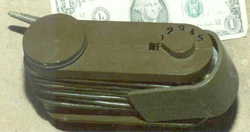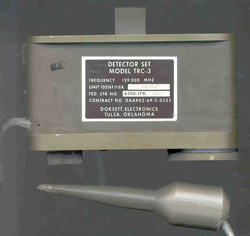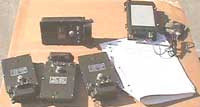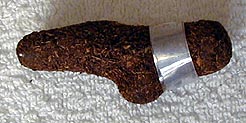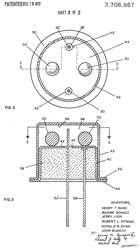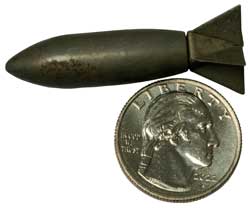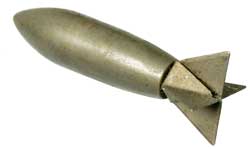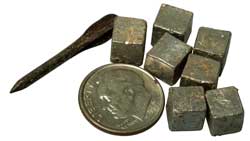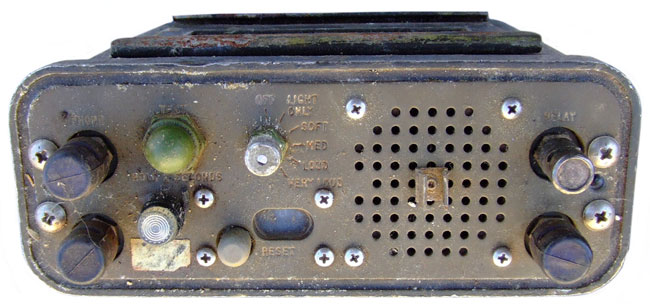TRC-3/3A Transmitter
The PCB has about 2 dozen transistors, a single crystal, a couple of adjustable inductors and 3 variable caps. The axial lead resistors are all standing up so that they take up less board space. The switch is located near the sensor input and has a number of resistors connected in series between contacts, like a voltage divider. The final transistor may be a TO-5 2N3866, all the other transistors look like Fairchild plastic units. There is a panel on the face opposite the label about 2x3.5" that is the PCB cover. It's been sealed by cementing the plastic together
The crystal oscillator is in the corner opposite the switch and feeds an RF chain ending with the antenna..
This is a single geophone combined with a radio transmitter. The transmitter only turns on when there is a sub sonic signal above a selectable threshold. I find that if I place it within 30' of my house at the least sensitive setting it goes off from my foot steps inside the house. At 100' from my house at the least sensitive setting if I jump in the house it will go off, but not with foot steps. So far I have not found a location where it will go off for a car coming into my drive way but not from me in the house. The fidelity is not as good as the PSR-1 maybe because of the radio link and the use of squelch on the receiver.
Photo showing the "single bump" indicating that this one sends out a single "beep" others send out 2,3 or more "beeps"
The frequency on this one is 129.000 MHz which is below the 160 to 176 MHz range of the UQS-46 sensor receiver.
The modulation is probably AM.
RC-3A PSID Receiver
This receiver is housed in a case with the same outline as the TRC-3/3A transmitter and runs on 2 each 9 Volt batteries. It has a coaxial output connecter that is 0.243" in diameter and has two lugs for a bayonet sytle mating connector. It has a male pin. This may be a "BN" connector, but I have not found a reference for it. These may be part of the GSQ-151 PSID system.
Stock number 6350-179-1560 (6350-179 matches the TRC-3/3A transmitter). Freq. 126.6 MHz
DAAK02-70-C-0577 is the contract number.Dorsett Electronics may now be part of LaBarge.
Headphone
This is a single earphone that has 3 straps with Velcro ends so you can install it under a helmet. The coax connector looks like a miniature BNC plug.
This headset mechanically plugs onto the URC-68 headphone jack, but does not function properly on that radio.
Being sold on eBay as: Military Intrusion Alarm Receiver Headset by j5w23
I have been told that this is a TRC-3 headset.
PEWS - Platoon early Warning Systems AN/TRS-2(V)
This set consists of one of the R-1808(V)x receivers and ten DT-577(V)x Detectors plus misc. other items. (the x is the version number and indicates the RF frequency as follows:
PEWS Set
PEWS Receiver
Note that all the frequencies are below the 160 to 176 MHz range of the UQS-46 sensor receiver.
The set can also be used in a wire line mode with the RF mode disabled. The DT-577 Detectors have both seismic and magnetic sensors. The magnetic sensor has a sensitive axis the DT-577 has an arrow to be aligned parallel to the path or road. You do not get to hear the sub sonic sounds with this unit, it only sends a digital byte of data with the area and sensor ID and the type of detection, either seismic or magnetic. If a deer sets it off the signal is the same as if a man set it off. You can not select either magnetic or seismic, you must always have both. I would like to have magnetic only - no deer would set it off. There is NO sound from the receiver, only a digital byte or two is sent, so you can not "hear" what's happening.
The key Technical Manuals are:
TM 11-5895-1047-10 Operators Manual
TM 11-5895-1047-23 Organization and Direct Support Maintenance Manual
TS-3565/TRS-2 can generate the digital messages like the sensor, but has no capability to receive data.
TM 11-6625-2784-14 Test Set, Receiver TS-3565/TRS-2(V) (NSN 6625-01-075-0046)
TM 11-6625-2784-24P Test Set, Receiver TS-3565
TM 11-6625-2784-14HR Test Set, Receiver TS-3565
The test set has capabilities similar to the TS-2963/USQ-46 Test Set except that the 3565 has only wire line outputs (an RF generator is needed for RF testing) and the data format is different. The PEWS equipment works with: Area: 3 bits, ID: 4 bits, Parity: 1 bit, Class (Seismic or Magnetic).TRS-2 was offered by Stano Components Inc. 1998
Patents
3644825 Magnetic detection system for detecting movement of an object utilizing signals derived from two orthogonal pickup coils, Paul D Davis Jr, Thomas E Mccullough, Texas Instruments, 1972-02-22, - cited by 149 patents!
